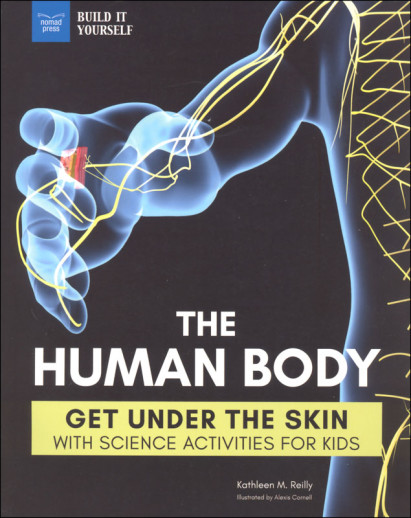We use cookies to make your experience better. To comply with the new e-Privacy directive, we need to ask for your consent to set the cookies. Learn more.
Human Body: Get Under the Skin with Science Activities for Kids (Build it Yourself)
This publication helps readers look inside the body's complicated systems with text that brings it to the student's level. There is a conversational tone as you read about the circulatory system, digestive tract, muscles, brain, senses, reproductive system, and more as kids learn how to take care of their bodies. Readers will learn a ton of new vocabulary words! Several activities are included requiring only household items such as the Make Your Own Fingerprint Kit using a graphite pencil, a loose brush and clear tape. These activities make the facts more memorable. Illustrations show a great deal of helpful detail and a cartoon element adds a smile to the readers face.
Did you know that your brain has up to 100 billion nerve cells? Wow! What else is going on in your body?
In The Human Body: Get Under the Skin with Science Activities for Kids, middle schoolers learn about the different bodily systems that keep people breathing, moving, thinking, and staying healthy! Kids get a good look at all the action that's going on right inside their own bodies, from understanding just how that apple turns into energy to how the "leftovers" make their exit.
By studying the circulatory system, the digestive system, muscles, bones, the brain, senses, reproduction system, and more, kids gain a deep understanding of why they can do the things they do and even learn about what they can do to take care of their bodies so they live long and healthy lives. Through science-minded STEM activities, readers see exactly how smoke affects the lungs, how the heart really acts as a liquid pump, and how the different joints are structured and serve different purposes.
The Human Body includes critical thinking exercises and essential questions related to anatomy. Fun facts, links to online primary sources and other supplemental material, plus graphic novel illustrations and photography encourage readers to take a deep dive under their skin!
Have you ever thought about the history of robotics, how we collect big data, or how cities were developed? This series explores the answer to those questions and many more by presenting the history behind these topics and how it has evolved into our modern-day era. Chapters begin with an essential question to think about as students read the information presented in an engaging and understandable format. The timeline, pictures, and "Did You Know?" facts also keep the reader's attention. Vocabulary words are in bold with definitions in the sidebars. Several projects are included at the end of each chapter. All the books (not including Cities) are in color and include primary sources you can access by scanning QR codes with a smartphone or tablet. Read the whole series as a science unit, or pick and choose the books that pique your interest. Students can keep a journal of their activities in a separate notebook. ~ Gina
| Product Format: | Paperback |
|---|---|
| Brand: | Nomad Press |
| Grades: | 4-7 |
| ISBN: | 9781619308015 |
| Length in Inches: | 10 |
| Width in Inches: | 8 |
| Height in Inches: | 0.3125 |
| Weight in Pounds: | 0.7 |

